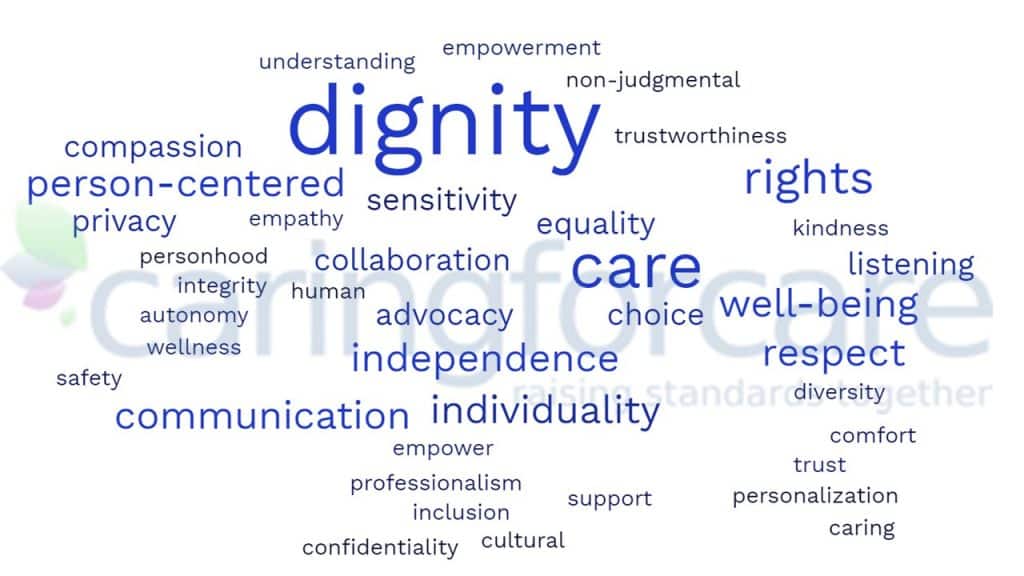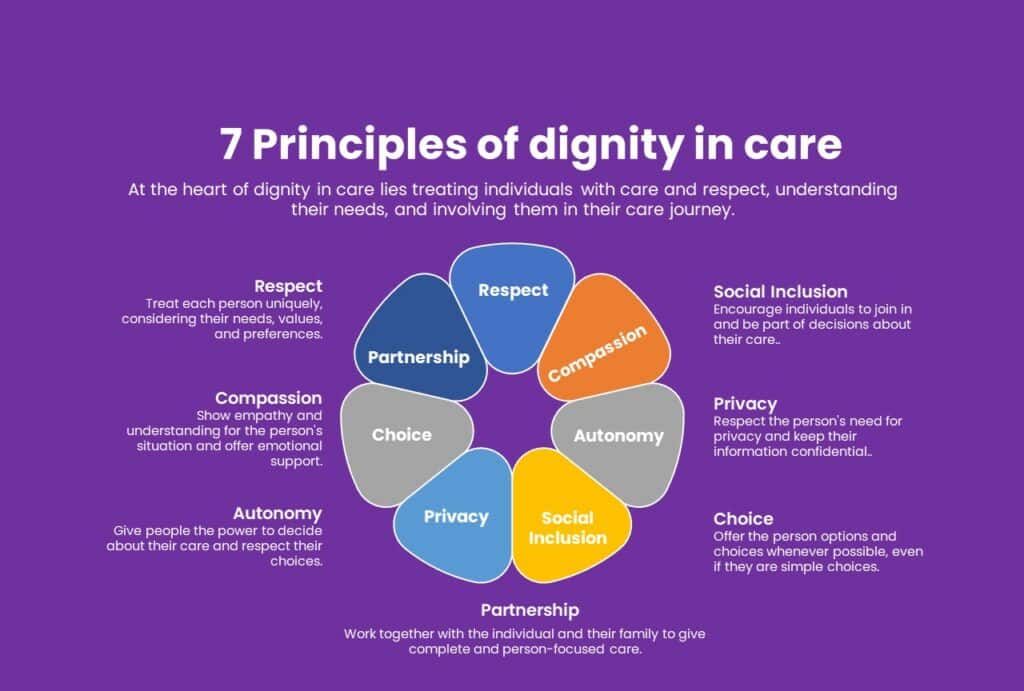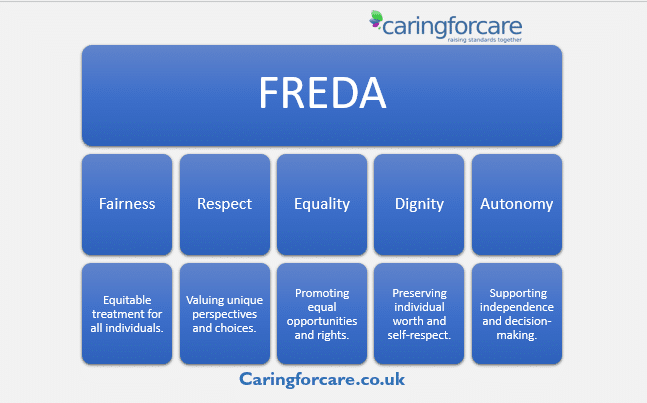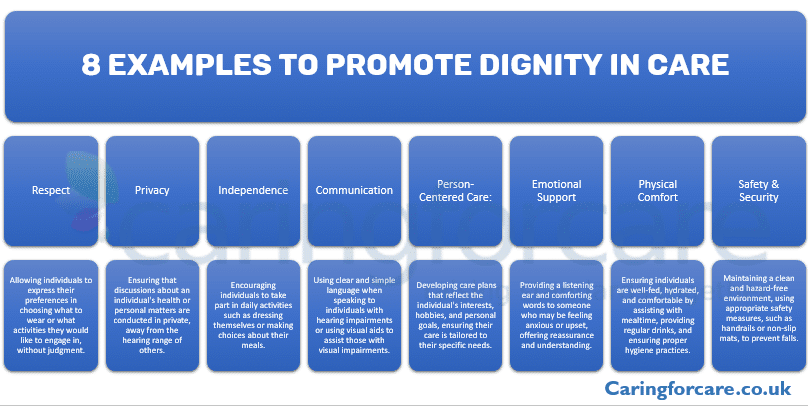Dignity in care and why it matters
Care workers provide high-quality support to many people so that they can live fulfilled lives. This is what dignity in care is all about, improving lives. It starts with carefully studying and noticing what is in the individual’s care plan. Individuals in care home are different and as such reviewing their care plan and following strictly their plan is important.
Reviewing the care plans of individuals residing in care homes is crucial as their needs and requirements can differ significantly. Similarly, adhering closely to their care plan is essential to ensure the maintenance of their health and wellbeing.
We refer to individuals who inspire and encourage others to uphold the values of dignity in care as dignity champions.
What we covered:
- What is dignity in care?
- Legislation and regulation
- What is dignity in care initiative?
- Who are dignity champions?
- The seven principles of dignity
- Understanding the FREDa Principles
- FREDA Principle and the Principles of dignity
- 8 examples of promoting dignity in care
- Dignity in Care training course
What is dignity in care?
Dignity is recognising and valuing every single person as a unique individual.
This means treating people fairly, and with compassion. It requires respect of other people’s views and choices, and a commitment to the belief that everyone has equal worth.
Dignity in care involves respecting and valuing individuals, supporting their independence, and showing compassion towards them.

What is dignity?
Dignity is the respect and value that everyone deserves as a human being. It means treating everyone with courtesy, consideration, and politeness, and respecting their choices, opinions, and beliefs, even if they differ from our own.
It also means recognising that everyone is equal, and that everyone has the right to make their own decisions about their life and body.
Dignity is important in healthcare because it means treating everyone with respect and compassion, regardless of their background, circumstances, or condition. It is also important in society because it means creating a just and compassionate world where everyone feels valued and respected.
What is dignity in healthcare?
Dignity means treating everyone with respect and compassion, regardless of their background, circumstances, or condition. It is also important in society because it means creating a just and compassionate world where everyone feels valued and respected.
Dignity in care also covers:
1. Maintaining a person’s “privacy at all times, for example if the person is asleep or does not have capacity”.
2. Ensuring that conversations about treatment are not conducted where they can be heard by others.
3. Keeping in mind person-centred values, such as individuality, independence, privacy, partnership, choice, respect and rights.
4. Making sure that “people using services should not have to share sleeping accommodation with others of the opposite sex, and should have access to segregated bathroom and toilet facilities without passing through opposite-sex areas to reach their own facilities.
LIMITED TIME OFFER – DIGNITY, PRIVACY AND RESPECT ONLINE TRAINING – CPD APPROVED CERTIFICATE
An overview of what dignity in care means:
- Dignity in care refers to providing care in a way that respects and maintains the self-worth and human rights of the people receiving support.
- It involves supporting people’s physical, emotional, spiritual, and cultural needs in a compassionate person-centered manner.
- Key elements include respecting privacy, preserving autonomy, honoring choices, maintaining confidentiality, fostering independence, and treating people as unique individuals.
- Dignity in care upholds concepts like informed consent, privacy, accountability, and preserving individuality in care interactions.
- The goal is to make people feel valued, comfortable, understood, and empowered even when relying on care and assistance.
- It represents a culture of respecting human rights, needs, and preferences when an individual is most vulnerable.
- Dignity should be upheld across all care settings like hospitals, care homes, hospices, and home care.
- Training, leadership, and protocols promote dignity, but individual staff compassion is fundamental for enabling people to retain their sense of self-worth and humanity.
In essence, dignity in care means providing necessary support in a way that preserves and reinforces people’s inherent value, esteem, and personhood.

Dignity in Care:
What are the laws and regulation?
Legislation and regulation
The Human Rights Act 1998 includes a number of human rights which protect the belief that everyone should be treated equally, and with dignity, regardless of their circumstances.
“A person should have the right to have access to public services and to be treated fairly by those services, respect for private and family life, and the right to liberty and security.” [Source: https://ccpdignity.co.uk/introduction/]
Regulation 10 of The Health and Social Care Act 2008 also highlights the need for people to have privacy when they need and want it, and to be provided with any support they may need to be autonomous, independent and involved in their local community.
The State of Care report is the Care Quality Commission’s (CQC) yearly assessment of social care and health care in England.
The 2018 report found that people who had both mental and physical illnesses faced significant challenges because their needs were not often treated together.
Physical health services did not always consider people’s mental health needs. The report also observed that some staff lack the right skills to manage the complicated needs of those suffering from a mental health condition.
What is dignity in care initiative?
The dignity in care initiative began in November 2006 and it refers to efforts and campaigns aimed at ensuring people receiving health and social care services are treated with dignity and respect.
Some of the key points on the dignity in care initiative are:
- It is a value-based approach to caregiving focused on preserving a person’s humanity and individuality.
- The initiative promotes making dignity a basic human right and core professional standard in care provision.
- It encompasses training, leadership, mentorship, regulations, and organizational culture shifts to make dignity foundational across care settings.
- Key focus areas include respect, autonomy, empowerment, high-quality personalized care, compassion, inclusion, and accountability.
- Dignity in care seeks to address issues like inadequate privacy, lack of independence, rushed care, insensitive language, objectification, discrimination, abuse, and system conditions that undermine dignity.
- Advocacy groups, government agencies, care provider associations, and other stakeholders promoting this initiative through campaigns, training programs, and other means.
- The goal is to embed dignity across care provision, environments, and systems so preserving and nurturing dignity becomes integral to daily practice at individual, institutional, and policy levels.
In summary, the dignity in care initiative aims to affirm dignity as an essential right and consistently demonstrate this respect in practical caregiving interactions.
LIMITED TIME OFFER – DIGNITY, PRIVACY AND RESPECT ONLINE TRAINING – CPD APPROVED
Who are dignity champions?
Dignity champions are people who help others learn how to be kind and respectful to people who need care. They show others how to do it and help them do their best.
Dignity Champions are very important because they help everyone understand how to be kind, respectful, and take good care of the people they are helping.
They teach others how to be good at their job and make sure everyone is treated with kindness and respect.
These champions can originate from any level of an organization, and they receive specialized training and development to expand their understanding of dignity in care.
They use their experience to help their colleagues deliver exceptional care that respects and advances the dignity of care recipients, promoting a caring, considerate, and person-centric model of care.
Ultimately, dignity champions play a vital role in any care environment, establishing an empathetic, courteous, and patient-focused standard of care.

Here are some of the dignity champion networks in the UK:
- Dignity in Care: A national campaign promoting dignity and respect in UK care services with over 150,000 Dignity Champions.
- Age UK: A charity focused on improving the lives of older people, with a network of over 10,000 Age Champions promoting dignity and respect.
- Carers UK: A charity supporting carers, with over 5,000 Carers Champions dedicated to promoting dignity and respect for carers.
- Sense: A charity working with people who are deafblind, with over 2,000 Sense Champions advocating for dignity and respect.
- Learning Disability Partnership: A charity supporting people with learning disabilities, with over 1,000 Learning Disability Champions promoting dignity and respect.
LIMITED TIME OFFER – MANDATORY CARE ONLINE TRAINING – CPD APPROVED
The seven principles of dignity
There are seven principles which provide a framework for care workers in the area of dignity. The principles highlight the importance of placing dignity at the heart of all care and support services.
They are applicable across all services, and provide good practice guidance. Of course, there is always more we can do, but having a framework to use is a good starting point.

1. Show Respect
Treat each person as a one-of-a-kind human with their own background, likes, dislikes, and needs – even if very different from your own. Make an effort to see beyond just symptoms or room numbers.
Respect religious beliefs, culture, gender identity, or other central values needing consideration during interactions.
Examples
- Nurse asks Muslim patient’s preferences discussing spiritual needs and accommodates schedule enabling proper prayer times facing Mecca.
- Physio incorporates Ukrainian patient’s preferred folk music adding therapy ball tossing rhythm to motivate movement goals amid isolation from homeland war tragedy.
- Care worker consistently reinforces selected pronouns and new name showing empathy as transitioning patient medically struggles with feeling trapped in misgendered body shape.
2. Use Compassion
Try showing true empathy, emotion, and sensitivity for the challenges someone facing health issues must cope with daily. Offer sincere encouragement and validate their feelings to uplift their spirits along with physical improvement.
Examples
- Listening without judgement over multiple sessions to a newly diagnosed cancer patient tearfully voicing worries links emerging treatment hopes with emotional reconciliation of pride, anger, and haunting regrets from lifelong strained family relationships now desperate to resolve before their end-of-life opportunity passes.
- A volunteer massage therapist regularly visits a hospice, providing gentle shoulder rubs during bone pain flares, redirecting the patient’s focus to soothing human touch amid isolation.
- A nurse practitioner approves an emergency clinic visit to find missing anxiety medication, understanding that being uninsured and fearing income vulnerability worsens mental health crises for a marginalised patient reliant on consistent mood-stabilising prescriptions.
3. Enable Their Choices
Inform and empower people to direct their own care path through the options clinicians lay out. Highlight choices whenever possible. Clinic décor, food menus, and activity timing may seem like minor issues amid health worries, but giving options and any control helps with psychological comfort.
- Physiotherapist and patient jointly adjust rehabilitation milestone goals to patient’s paced comfort level despite institutional protocol targets.
- Social worker appeals restrictive ward policy enabling supervised garden fresh air breaks honoring clinical depression patient’s felt psychological benefits.
- Case manager schedules technology training on voice-assisted TV remote accommodating autonomy within physical limitations.
4. Involve Them (social inclusion)
Seek to actively include the care receiver during meetings, ward rounds, goal setting, or even just casual check-ins along with family invited to participate. It relieves isolation, bridges understanding, and keeps priorities aligned centered around that person.
Examples
- Occupational therapist engages a young adult patient’s apartment mates to elicit peer home living supports and potential joint creative pursuits, providing youthful normalizing mental wellness motivation amid schizophrenia management.
- Music enthusiast volunteer offers the role of ward DJ, curating preferred patient-selected playlists to add a personalised atmosphere.
- Care manager emails patient summary video links of multidisciplinary case conference priorities, inviting written responses and recommendations.
5. Ensure Privacy
Knock before entering rooms. Strategically cover up exposed areas during procedures. Lower voices when discussing issues nearby. Protect confidential personal, financial, and clinical information access vigilantly.
Examples
- Clinic staff realise open visitor seating allows waiting patients to easily overhear check-in conversations so they add sound baffling room dividers.
- Doctor begins electronic health record charting only after drawing bedside curtains closed.
- Emergency assistance knocks waiting over 20 seconds before entering bathroom assisting fallen patient preserving dignity.
6. Offer Flexible Compassion
Accommodate customised improvements suiting spiritual, emotional, or even simple preference needs – like adjustments enabling video calls, reading tablets, or preferred pajamas from home. Such tailored flexibility goes far in preserving identity.
Examples
- Care home staff realise vegetable purees worsen appetite, so add a daily patient-chosen alternative from the written menu.
- Volunteer Doula suggests alternating birthing ball and bath during long latent labour as the woman directs.
- Janitor cleans room twice, offering air-freshening scent options.
7. Collaborate on Care
Work together with the patient and loved ones through two-way communication, shared knowledge, agreed responsibilities, and patient-guided commitments to nurture an empowering partnership. This sustains dignity over long treatment journeys.
Examples
- Counsellor elicits examples of previous workplace strengths and strategises addressing hiring barriers transparently despite symptoms as the patient resets professional goals.
- Oncologist approves a 6-week immunotherapy gap considering clinic access hardship voiced by sister despite eligibility ending, allowing functional quality time attending son’s distant wedding.
- Discharge planner suggests area faith-based group meals, discovering community belonging and diet support in the patient’s neighbourhood.
This 7 principles of dignity recognises that there may be times when it becomes necessary to address certain behaviors, actions, or situations that compromise the well-being or safety of the individual.
Furthermore, it emphasises the importance of approaching these challenges with sensitivity, empathy, and a focus on maintaining their dignity throughout the process.
Top Pick Online Course – Dignity, Privacy and Respect Online Training – CPD Approved
Understanding the FREDA Principles
FREDa principles are essential for fostering inclusive and person-centered care. FREDa is an acronym that stands for Fairness, Respect, Equality, Dignity, and Autonomy. It is often used in the context of promoting inclusive and person-centered care, particularly in health and social care settings.
- Fairness ensures equitable treatment for all individuals.
- Respect emphasizes valuing each person’s unique perspectives and choices.
- Equality promotes equal opportunities and rights.
- Dignity focuses on preserving individual worth and self-respect.
- Autonomy recognizes and supports individuals’ independence and decision-making.
Applying FREDa principles creates a caring environment that respects diversity and promotes positive interactions in healthcare settings.

FREDa is a mnemonic method that serves as a useful reminder of key principles when communicating or engaging with individuals. It helps ensure that interactions are respectful, inclusive, and considerate of people’s rights and needs.
By applying the FREDA principles, individuals can establish a positive and supportive environment, fostering effective communication, mutual understanding, and building trust.
Using FREDA helps promote dignity, respect, and inclusivity in various professional and personal interactions.
How do the FREDa principles align with the 7 principles of dignity in care?
The FREDa principles are a subset of the broader principles of promoting dignity in care.
While the FREDa principles specifically focus on person-centered care, the principles of dignity in care encompass a wider range of aspects related to respecting and upholding an individual’s dignity.
The FREDa principles (Friendship, Respect, Equality, Dignity, and Autonomy) can be seen as specific elements within the broader principles of promoting dignity in care.
Both sets of principles aim to guide and inform the provision of care that respects and preserves the dignity of individuals.
BUY NOW – THE CARE CERTIFICATE -FULL PACKAGE – INSTANT CERTIFICATE DOWNLOAD
8 examples of promoting dignity in care
1. Respect:
Treating others with dignity by showing respect for their autonomy, choices, and individuality.
Example: Allowing individuals to express their preferences in choosing what to wear or what activities they would like to engage in, without judgment.
2. Privacy:
Respecting others’ right to privacy and maintaining confidentiality in their personal information and care.
Example: Ensuring that discussions about an individual’s health or personal matters are conducted in private, away from the hearing range of others.
3. Independence:
Promoting and supporting others’ independence, empowering them to make decisions and be actively involved in their care.
Example: Encouraging individuals to take part in daily activities such as dressing themselves or making choices about their meals.
4. Communication:
Ensuring effective and respectful communication, considering others’ communication needs and preferences.
Example: Using clear and simple language when speaking to individuals with hearing impairments or using visual aids to assist those with visual impairments.

5. Person-Centered Care:
Providing personalized care that focuses on others’ unique needs, preferences, and goals.
Example: Developing care plans that reflect the individual’s interests, hobbies, and personal goals, ensuring their care is tailored to their specific needs.
6. Emotional Support:
Offering empathy, compassion, and emotional support to others, acknowledging and validating their feelings and experiences.
Example: Providing a listening ear and comforting words to someone who may be feeling anxious or upset, offering reassurance and understanding.
7. Physical Comfort:
Ensuring others’ physical comfort and well-being, addressing their needs for nutrition, hydration, hygiene, and pain management.
Example: Ensuring individuals are well-fed, hydrated, and comfortable by assisting with mealtime, providing regular drinks, and ensuring proper hygiene practices.
8. Safety and Security:
Creating a safe and secure environment, protecting others from harm, and promoting their overall well-being.
Example: Maintaining a clean and hazard-free environment, using appropriate safety measures, such as handrails or non-slip mats, to prevent falls.
By promoting these principles of dignity in care, we can create an environment where everyone feels respected, valued, and supported in their unique needs and experiences.
We also wrote a post on the ways and examples that promotes dignity in care.

“Every human being, of whatever origin, of whatever station, deserves respect.
We must each respect others even as we respect ourselves.”
– U. Thant
What Next? Start Dignity in Care training course
Caring for Care’s Dignity in Care training course further explores the above principles of dignity in care.
The course targets anyone who works with people using health and social care.
It looks in more detail at person-centred care, best practice of communication, how to meet the CQC’s standards for dignity in care, and how to work with kindness and respect.
Practicing healthcare professionals, who understand the unique needs and challenges you face, deliver the course. You can deliver the training of professional healthcare staff as a group or on-site.
Taking all of the above information into consideration, it’s evident that everyone can benefit from acquiring the skill of understanding and implementing dignity in care into their daily lives.
It underpins the approach to working with those individuals who use health and social care services, and is therefore a key priority for all in the workforce.
People Also Read:
10 Ways and Examples to Promote Dignity and Respect
- Wound Assessment and Documentation: Mastering Key Steps for Better Care
- Understanding Bereavement Support and Duties of Different Healthcare Groups.
- What are Vital Signs in Nursing?
- Hoist Training for Carers: Ensuring Safe and Efficient Patient Transfers
- Power of Person-Centred Care: Putting Patients First for Better Outcomes
Let us Help you
We’ll help you find the right course for your needs. Tell us a little bit about your situation and what you would like to achieve.
We’ll get back to you within one working day.
